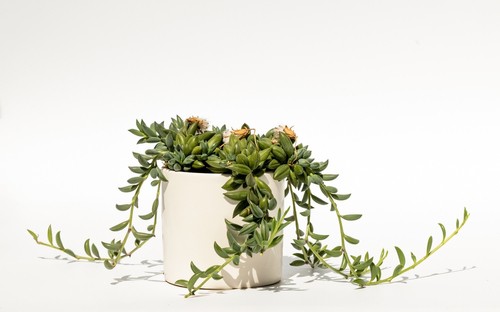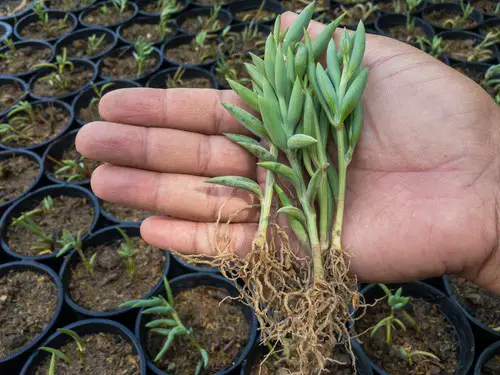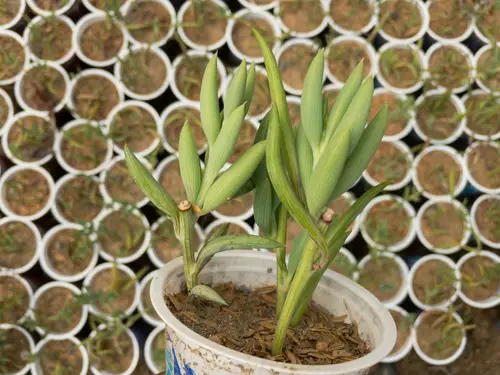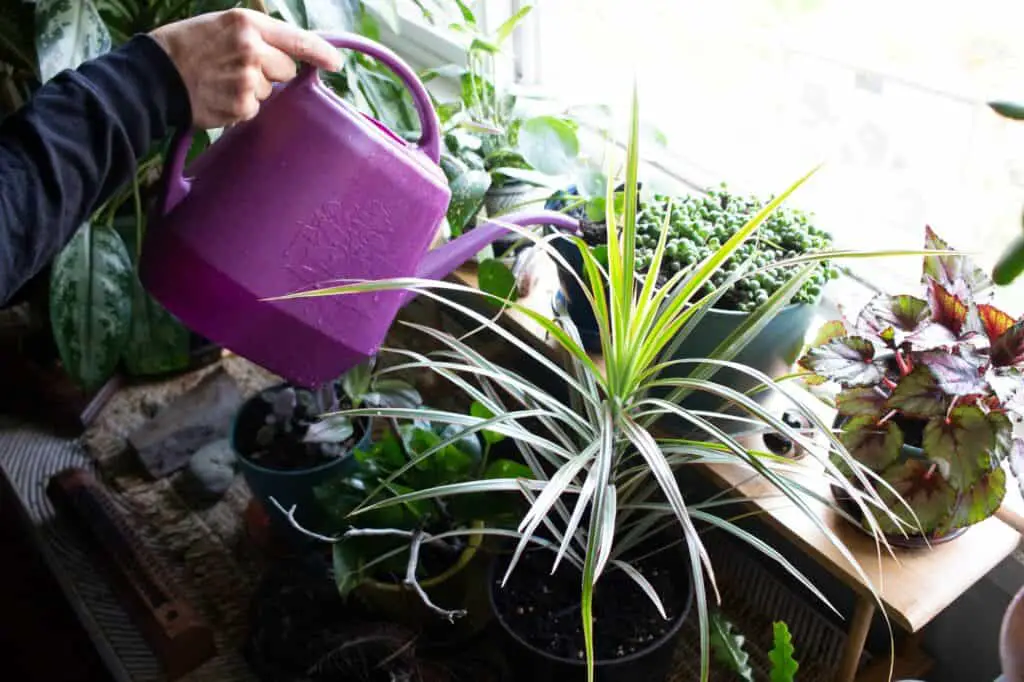The fish hook plant, also known as Senecio radicans, is a popular trailing succulent that is native to South Africa. It is a low-maintenance plant that is easy to care for, making it a favorite among many gardeners.
However, despite its hardiness, the fish hook plant can sometimes suffer from various issues that can cause it to die. In this article, we will explore the reasons why a fish hook plant may be dying and what you can do to save it.
Understanding the fish hook plant is crucial to its care. It is a succulent that thrives in bright, indirect light and well-draining soil. Overwatering is a common issue that can lead to root rot and ultimately kill the plant. On the other hand, underwatering can cause the plant to dry out and die.
If you notice that your fish hook plant is not thriving, it is essential to diagnose the issue and take action accordingly. In the following sections, we will explore the ideal growing conditions for the fish hook plant, common pests and diseases, and how to propagate and transplant it.
Key Takeaways on Fish Hook Plant Dying
- The fish hook plant is a popular trailing succulent that is easy to care for.
- Overwatering and underwatering are common issues that can lead to the death of a fish hook plant.
- Understanding the ideal growing conditions, common pests and diseases, and how to propagate and transplant the fish hook plant can help you diagnose and treat any issues it may be facing.
Check out other reasons why your favorite plants might be dying:
Understanding the Fish Hook Plant

The fish hook plant, also known as the string of fishhooks, is a popular indoor plant that belongs to the Senecio family. Its botanic moniker is Senecio radicans, but it is commonly known by its common name, fish hook plant.
It is a trailing succulent that is native to South Africa and can grow up to 3 feet long. The plant is characterized by its small, grey-green leaves that resemble fishhooks, hence the name.
The fish hook plant is a hardy indoor plant that is easy to care for. It is an ideal plant for those who want to add some greenery to their home without having to spend too much time and effort on maintenance.
It is a popular choice for hanging baskets due to its trailing nature and is often used in combination with other trailing succulents such as the string of bananas or the string of pearls.
One of the reasons why the fish hook plant is so popular is because it is a low-light plant, which means it can thrive in areas with minimal sunlight.
However, it still needs some indirect light to grow properly, so it is best to place it near a window that receives some natural light. Direct sunlight can scorch the leaves, so it is important to avoid placing it in direct sunlight.
The fish hook plant is a drought-tolerant plant that can go for long periods without water. However, it is important to ensure that the soil is completely dry before watering it again.
Overwatering can cause the roots to rot, which can lead to the death of the plant. It is best to water the plant sparingly, only when the soil is completely dry.
Ideal Growing Conditions
To keep a fish hook plant healthy, it is important to provide it with the ideal growing conditions. Fish hook plants can handle a wide range of temperatures, from 25 to 100 degrees Fahrenheit, but extreme temperature fluctuations can cause the plant to suffer. It is best to grow it as a houseplant where the temperature can be controlled more easily.
Fish hook plants require bright indirect light or direct eastern light. If the plant is not getting enough light, it can become leggy and weak. Placing the plant near a window that receives bright, indirect light is recommended. If the plant is not getting enough light, it may be necessary to supplement with artificial light.
Watering is a crucial aspect of fish hook plant care. The soil should be allowed to dry out between waterings, and the plant should never be allowed to sit in standing water.
It is important to ensure that the water is reaching the roots, as the soil can become hydrophobic and prevent water from penetrating. Soaking the plant thoroughly can help ensure that the roots are getting enough water.
The soil should be well-draining and not too dense. A cactus mix or a mixture of sand, perlite, and peat moss can be used to provide good drainage. The pot should also have drainage holes to prevent water from accumulating at the bottom.
Fish hook plants are low-maintenance and can tolerate a wide range of growing conditions. They are also known to be drought-tolerant, so they are a great choice for those who may forget to water their plants regularly.
However, it is important to ensure that the plant is not exposed to temperatures that are too cool or too hot, as this can cause the plant to suffer.
Fish Hook Plant Care

Fish hook plant, also known as the string of fishhooks, is a trailing succulent that makes an excellent addition to any indoor garden. However, like any other plant, it can fall victim to various diseases and pests that can cause it to die. Proper care is essential to keep the fish hook plant healthy and thriving.
1. Watering
The fish hook plant prefers well-draining soil and should be watered thoroughly but infrequently. Overwatering can lead to root rot, which can be fatal to the plant.
Allow the soil to dry out completely before watering again. During the growing season, the plant may require more frequent watering, but be sure to check the soil moisture level before watering.
2. Light Requirements
Bright indirect light is the key to the success of the fish hook plant. This succulent thrives in bright light as long as it doesn’t get direct exposure to the full sun. If the plant is not getting enough light, bring it closer to an open window facing west or south. That way, it will get the most out of the light.
3. Fertilizer
Fish hook plant does not require frequent fertilization. However, it can benefit from occasional feeding during the growing season. Use a balanced fertilizer diluted to half strength once a month. Alternatively, you can use worm castings or organic compost to provide nutrients to the plant.
4. Pruning
Pruning is not necessary for the fish hook plant, but it can help to keep the plant looking tidy and prevent it from becoming too leggy. Use clean, sharp scissors to trim back any dead or damaged stems. You can also pinch back the tips of the stems to encourage bushier growth.
5. Hanging Basket or Wall Pots
The fish hook plant is an excellent choice for a hanging basket or wall pot. It can trail up to several feet, making it an ideal plant to add vertical interest to any room. Be sure to choose a container with good drainage to prevent overwatering.
Fish Hook Plant Dying

A fish hook plant is a unique succulent that is easy to care for. However, there are times when the plant may start to show signs of distress, and it is important to know what to look for to save it from dying.
1. Leaves Turning Brown or Yellow
One of the most common signs of a dying fish hook plant is the leaves turning brown or yellow. This can be caused by overwatering, underwatering, or exposure to direct sunlight. If the leaves are turning brown, it is a sign that the plant is not getting enough water, while yellowing leaves indicate overwatering.
2. Stem and Stems Turning Soft
If the stem or stems of the fish hook plant are turning soft, it is a sign that the plant is dying. This can be caused by overwatering, which can lead to root rot and the plant’s death. It is important to check the soil’s moisture level and reduce watering if necessary.
3. No New Growth
If the fish hook plant is not producing any new growth, it is a sign that the plant is in distress. This can be caused by a lack of nutrients or sunlight. It is essential to ensure that the plant is getting enough sunlight and nutrients to promote healthy growth.
4. Wrinkled Leaves
Wrinkled leaves are another sign of a dying fish hook plant. This can be caused by underwatering or overfertilization. It is important to ensure that the plant is getting enough water and to avoid overfertilization.
Common Pests and Diseases
Fish hook plants are susceptible to a variety of pests and diseases that can cause them to wither and die. Here are some of the most common pests and diseases to watch out for:
Pests

1. Mealybugs
Mealybugs are one of the most common pests that can infest fish hook plants. They are small, white insects that feed on the plant’s sap, causing the leaves to wilt and turn yellow. Mealybugs can be treated by isolating the plant from other plants and applying an insecticidal soap or neem oil spray.
2. Diseases
Fish hook plants can also fall victim to various diseases that can cause them to die. Here are some of the most common diseases to watch out for:
3. Root Rot
Root rot is a fungal disease that can be caused by overwatering or poor drainage. It causes the roots to rot and can lead to the plant’s death. To prevent root rot, make sure the soil is well-draining and avoid overwatering the plant.
4. Leaf Spot
Leaf spot is a fungal disease that causes brown or black spots to appear on the leaves of the plant. It can be caused by overwatering or high humidity. To treat leaf spot, remove the affected leaves and reduce the plant’s humidity levels.
5. Powdery Mildew
Powdery mildew is a fungal disease that causes a white, powdery coating to appear on the leaves of the plant. It can be caused by high humidity or poor air circulation. To treat powdery mildew, remove the affected leaves and increase the plant’s air circulation.
Propagating Fish Hook Plants
Fish hook plants are relatively easy to propagate and can be done through stem cuttings. The best time to propagate is during the spring or summer months when the plant is actively growing.
To propagate a fish hook plant, follow these steps:
- Choose a healthy stem that is at least 4 inches long and has several leaves.
- Cut the stem with a sharp, clean pair of scissors or pruning shears. Make sure the cut is clean and not ragged.
- Remove the leaves from the bottom 2 inches of the stem. This is where the roots will grow.
- Dip the cut end of the stem in rooting hormone powder. This will help stimulate root growth.
- Plant the stem in a well-draining soil mix. Water the soil thoroughly and place the pot in a bright, indirect light.
- Keep the soil moist but not waterlogged. After a few weeks, the stem should start to root and new growth should appear.
- Once the new growth is established, the plant can be moved to a larger pot or planted in the ground.
It’s important to note that fish hook plants are toxic to pets and humans if ingested. Keep them out of reach of children and pets.
Transplanting and Repotting

Transplanting and repotting are essential for the growth and survival of a fish hook plant. However, if not done correctly, it can cause the plant to die. Transplanting involves moving a plant from one location to another, while repotting involves transferring a plant from one pot to another.
Fish hook plants should be repotted every one to two years, depending on their growth rate. When repotting, it is crucial to choose a pot that is one size larger than the current pot. The new pot should have drainage holes at the bottom to prevent waterlogging.
Before repotting, it is recommended to water the plant to make it easier to remove it from the current pot. The plant should be gently lifted out of the pot, and any dead or damaged roots should be trimmed with pruning shears. The new pot should be filled with fresh potting soil, leaving enough space at the top for the plant.
When transplanting a fish hook plant, it is essential to choose the right location. The plant should be moved to a location with the right amount of light, water, and temperature. Transplanting should be done during the plant’s dormant period, which is usually in the fall or winter.
Transplant shock is a common problem that occurs when a plant is moved from one location to another. It can cause the plant to wilt, drop leaves, or die.
To prevent transplant shock, it is recommended to water the plant thoroughly before and after transplanting. The plant should also be placed in a shaded area for a few days to help it acclimate to its new environment.
Toxicity of Fish Hook Plants
Fish hook plants, scientifically known as Fuchsia venusta, are generally non-toxic to humans and pets. However, it is important to note that some people may have allergies or sensitivities to certain plants, so it is always best to handle them with care.
While the fish hook plant is not toxic, it is still important to keep it out of reach of children and pets. Ingesting any plant material can cause gastrointestinal upset, such as vomiting and diarrhea. If a person or pet ingests a fish hook plant, it is recommended to seek medical attention immediately.
It is also important to note that some plants may be mislabeled or confused with the fish hook plant, and may actually be toxic. Always double check the identification of any plant before bringing it into your home or garden.
Diagnosing Issues
When a fish hook plant is dying, it’s important to determine the cause of the problem before attempting to fix it. There are a few common issues that can cause a fish hook plant to decline, including overwatering, underwatering, lack of light, and temperature fluctuations.
To diagnose issues with a fish hook plant, it’s important to observe the plant and take note of any symptoms it’s exhibiting. Some common symptoms of a sick fish hook plant include:
- Yellowing or browning leaves
- Drooping or wilting leaves
- Stunted growth or lack of new growth
- Brown or black spots on leaves
- Leaves falling off the plant
Once you’ve identified the symptoms, you can begin to narrow down the possible causes. Here are some common issues and how to diagnose them:
1. Overwatering

Overwatering is a common issue with fish hook plants, and it can cause the roots to rot and the plant to decline. To diagnose overwatering, check the soil for moisture. If the soil feels wet or soggy, the plant is likely being overwatered. Additionally, the leaves may turn yellow or brown and fall off the plant.
2. Underwatering
Underwatering is another common issue with fish hook plants, and it can cause the leaves to wilt and turn brown. To diagnose underwatering, check the soil for dryness. If the soil feels dry to the touch, the plant is likely not receiving enough water.
3. Lack of Light
Fish hook plants require bright, indirect light to thrive. If the plant is not receiving enough light, it may become leggy and the leaves may turn yellow or brown. To diagnose a lack of light, check the plant’s location. If it’s not near a window or under a grow light, it may not be receiving enough light.
4. Temperature Fluctuations
Fish hook plants prefer warm temperatures and can be sensitive to temperature fluctuations. If the plant is exposed to extreme temperatures, it may become stressed and the leaves may turn yellow or brown.
To diagnose temperature fluctuations, check the plant’s location. If it’s near a drafty window or in a room that’s too hot or cold, it may be experiencing temperature fluctuations.
Happy Gardening
Taking care of plants can be a rewarding experience, but it can also be frustrating when things don’t go as planned. The fish hook plant is no exception. However, there are steps that can be taken to help ensure a successful gardening experience.
One important factor in happy gardening is understanding the needs of the plant. The fish hook plant, for example, is a succulent that prefers bright, indirect light and well-draining soil.
Overwatering can lead to root rot and ultimately the death of the plant. On the other hand, underwatering can cause the leaves to shrivel and turn brown.
Another key to happy gardening is being proactive. Regularly checking the plant for signs of stress, such as yellowing leaves or wilting, can help catch problems early on. In addition, taking preventative measures, such as using a well-draining soil mix and avoiding overwatering, can help prevent issues from arising in the first place.
It’s also important to remember that not all plants are created equal. Each plant has its own unique needs and preferences. Taking the time to research the specific requirements of a plant before purchasing it can help ensure a successful gardening experience.
Frequently Asked Questions
How often should I water my String of Fish Hooks plant?
String of Fish Hooks plants are succulents and do not require frequent watering. Overwatering is one of the most common reasons for their death. Water the plant only when the top inch of soil is dry to the touch. During the winter months, reduce watering frequency.
What are the most common reasons for a String of Turtles plant to die?
The most common reasons for a String of Turtles plant to die are overwatering, underwatering, lack of sunlight, and pests. Ensure that the plant is not sitting in water and that the soil is well-draining.
Place the plant in a bright, indirect light location. Check for pests regularly and take necessary measures to control them.
How can I revive a dying String of Dolphins plant?
If a String of Dolphins plant is dying, it may be due to underwatering or overwatering. First, ensure that the plant is not sitting in water and that the soil is well-draining.
Water the plant only when the top inch of soil is dry to the touch. If the plant is severely dehydrated, submerge the pot in a container of water for a few hours to allow the soil to absorb water. Prune any dead or yellow leaves.
What are the best indoor care tips for a String of Bananas plant?
String of Bananas plants prefer bright, indirect light but can tolerate low light conditions. Water the plant only when the top inch of soil is dry to the touch.
During the winter months, reduce watering frequency. Fertilize the plant once a month during the growing season with a balanced fertilizer.
How do I know if my Fish Hook plant needs pruning?
Fish Hook plants grow long, trailing stems that can become leggy and sparse. Prune the stems to promote bushier growth and prevent the plant from becoming too long and straggly. Use clean, sharp scissors or pruning shears to trim the stems just above a leaf node.
What are some common issues that can cause a Fish Hook plant to dry up?
The most common issues that can cause a Fish Hook plant to dry up are underwatering, lack of sunlight, and low humidity. Ensure that the plant is not sitting in water and that the soil is well-draining.
Place the plant in a bright, indirect light location. Increase humidity levels by placing a humidifier nearby or placing a tray of water near the plant.

Hey, I’m Lisa and I’ve been an avid gardener for over 30 years. I love writing, talking and living in the garden! Feel free to connect with me on my socials below

